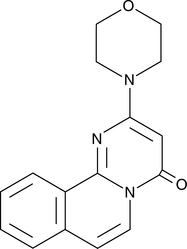Chemicals
Showing 15301–15450 of 41137 results
-
Combretastatin A1 is a cis-stilbene originally isolated from C. caffrum that inhibits microtubule assembly (ID50 = 2 µM) by binding to the colchicine (Item No. 9000760) binding site on β-tubulin.{38547,38548} It inhibits proliferation of hepatocellular carcinoma (IC50s = 9.2-728.2 nM) and other carcinoma cell lines (IC50s = 12.2-2,247 nM).{38548} Combretastatin A1 increases apoptosis of HepG2 cells in a GSK3β-dependent manner by decreasing the levels of MCL-1 and β-catenin. It inhibits tumor growth in a hepatocellular carcinoma mouse xenograft model when administered at doses of 2 or 4 mg/kg for 4 weeks. It also enhances the effects of carboplatin (Item No. 13112), paclitaxel (Item No. 10461), and cisplatin (Item No. 13119) in murine models of cancer.{38549,38550} Combretastatin A1 decreases functional vascular volume within hours in a well-vascularized murine colon adenocarcinoma model.{38551}
Brand:CaymanSKU:19750 -Available on backorder
Combretastatin A1 is a cis-stilbene originally isolated from C. caffrum that inhibits microtubule assembly (ID50 = 2 µM) by binding to the colchicine (Item No. 9000760) binding site on β-tubulin.{38547,38548} It inhibits proliferation of hepatocellular carcinoma (IC50s = 9.2-728.2 nM) and other carcinoma cell lines (IC50s = 12.2-2,247 nM).{38548} Combretastatin A1 increases apoptosis of HepG2 cells in a GSK3β-dependent manner by decreasing the levels of MCL-1 and β-catenin. It inhibits tumor growth in a hepatocellular carcinoma mouse xenograft model when administered at doses of 2 or 4 mg/kg for 4 weeks. It also enhances the effects of carboplatin (Item No. 13112), paclitaxel (Item No. 10461), and cisplatin (Item No. 13119) in murine models of cancer.{38549,38550} Combretastatin A1 decreases functional vascular volume within hours in a well-vascularized murine colon adenocarcinoma model.{38551}
Brand:CaymanSKU:19750 -Available on backorder
Commendamide is a natural bacterial product that was discovered in a screen for commensal bacteria effector genes (Cbegs).{29551} Cbeg12 is a bacterial effector gene that encodes for its production. Commendamide is structurally similar to long-chain N-acyl-amides, which commonly signal, in mammals, through G protein-coupled receptors. Commendamide activates GPR132 (also known as G2A) with an EC50 value of 11.8 µM.{29551}
Brand:CaymanSKU:-Available on backorder
Commendamide is a natural bacterial product that was discovered in a screen for commensal bacteria effector genes (Cbegs).{29551} Cbeg12 is a bacterial effector gene that encodes for its production. Commendamide is structurally similar to long-chain N-acyl-amides, which commonly signal, in mammals, through G protein-coupled receptors. Commendamide activates GPR132 (also known as G2A) with an EC50 value of 11.8 µM.{29551}
Brand:CaymanSKU:-Available on backorder
Commendamide is a natural bacterial product that was discovered in a screen for commensal bacteria effector genes (Cbegs).{29551} Cbeg12 is a bacterial effector gene that encodes for its production. Commendamide is structurally similar to long-chain N-acyl-amides, which commonly signal, in mammals, through G protein-coupled receptors. Commendamide activates GPR132 (also known as G2A) with an EC50 value of 11.8 µM.{29551}
Brand:CaymanSKU:-Available on backorder
Commendamide is a natural bacterial product that was discovered in a screen for commensal bacteria effector genes (Cbegs).{29551} Cbeg12 is a bacterial effector gene that encodes for its production. Commendamide is structurally similar to long-chain N-acyl-amides, which commonly signal, in mammals, through G protein-coupled receptors. Commendamide activates GPR132 (also known as G2A) with an EC50 value of 11.8 µM.{29551}
Brand:CaymanSKU:-Available on backorder
Complanatuside is a flavonoid glucoside originally isolated from A. complanatus.{47473} It inhibits nitric oxide (NO) production in LPS-stimulated RAW 264.7 cells (IC50 = 21.2 μM).{47474}
Brand:CaymanSKU:27295 - 10 mgAvailable on backorder
Complanatuside is a flavonoid glucoside originally isolated from A. complanatus.{47473} It inhibits nitric oxide (NO) production in LPS-stimulated RAW 264.7 cells (IC50 = 21.2 μM).{47474}
Brand:CaymanSKU:27295 - 100 mgAvailable on backorder
Complanatuside is a flavonoid glucoside originally isolated from A. complanatus.{47473} It inhibits nitric oxide (NO) production in LPS-stimulated RAW 264.7 cells (IC50 = 21.2 μM).{47474}
Brand:CaymanSKU:27295 - 25 mgAvailable on backorder
Complanatuside is a flavonoid glucoside originally isolated from A. complanatus.{47473} It inhibits nitric oxide (NO) production in LPS-stimulated RAW 264.7 cells (IC50 = 21.2 μM).{47474}
Brand:CaymanSKU:27295 - 50 mgAvailable on backorder
Used with Autokit CH50 catalog no. 995-40801
Brand:FUJIFILM Medical Systems USASKU:991-43701Available on backorder
Compound 401 is an inhibitor of DNA-dependent protein kinase (DNA-PK) and mammalian target of rapamycin (mTOR; IC50s = 0.28 and 5.3 µM, respectively).{42995} It is selective for DNA-PK and mTOR over PI3K, ATM, and ATR (IC50s = >100 µM for all). Compound 401 (10 µM) inhibits phosphorylation of the mTOR targets S6K1 and Akt in Rat-1 fibroblasts and in M059J glioma cells that lack DNA-PK.{42996} It inhibits proliferation of mouse embryonic fibroblasts (MEFs) lacking tuberous sclerosis complex 1 (TSC1-/-; IC50 = 2 µM), a complex associated with hamartomas that display hyperactive mTOR signaling, but not TSC1+/+ MEFs. Compound 401 also induces apoptosis in TSC1-/- MEFs.
Brand:CaymanSKU:21769 -Out of stock
Compound 401 is an inhibitor of DNA-dependent protein kinase (DNA-PK) and mammalian target of rapamycin (mTOR; IC50s = 0.28 and 5.3 µM, respectively).{42995} It is selective for DNA-PK and mTOR over PI3K, ATM, and ATR (IC50s = >100 µM for all). Compound 401 (10 µM) inhibits phosphorylation of the mTOR targets S6K1 and Akt in Rat-1 fibroblasts and in M059J glioma cells that lack DNA-PK.{42996} It inhibits proliferation of mouse embryonic fibroblasts (MEFs) lacking tuberous sclerosis complex 1 (TSC1-/-; IC50 = 2 µM), a complex associated with hamartomas that display hyperactive mTOR signaling, but not TSC1+/+ MEFs. Compound 401 also induces apoptosis in TSC1-/- MEFs.
Brand:CaymanSKU:21769 -Out of stock
Compound 401 is an inhibitor of DNA-dependent protein kinase (DNA-PK) and mammalian target of rapamycin (mTOR; IC50s = 0.28 and 5.3 µM, respectively).{42995} It is selective for DNA-PK and mTOR over PI3K, ATM, and ATR (IC50s = >100 µM for all). Compound 401 (10 µM) inhibits phosphorylation of the mTOR targets S6K1 and Akt in Rat-1 fibroblasts and in M059J glioma cells that lack DNA-PK.{42996} It inhibits proliferation of mouse embryonic fibroblasts (MEFs) lacking tuberous sclerosis complex 1 (TSC1-/-; IC50 = 2 µM), a complex associated with hamartomas that display hyperactive mTOR signaling, but not TSC1+/+ MEFs. Compound 401 also induces apoptosis in TSC1-/- MEFs.
Brand:CaymanSKU:21769 -Out of stock
Compound 401 is an inhibitor of DNA-dependent protein kinase (DNA-PK) and mammalian target of rapamycin (mTOR; IC50s = 0.28 and 5.3 µM, respectively).{42995} It is selective for DNA-PK and mTOR over PI3K, ATM, and ATR (IC50s = >100 µM for all). Compound 401 (10 µM) inhibits phosphorylation of the mTOR targets S6K1 and Akt in Rat-1 fibroblasts and in M059J glioma cells that lack DNA-PK.{42996} It inhibits proliferation of mouse embryonic fibroblasts (MEFs) lacking tuberous sclerosis complex 1 (TSC1-/-; IC50 = 2 µM), a complex associated with hamartomas that display hyperactive mTOR signaling, but not TSC1+/+ MEFs. Compound 401 also induces apoptosis in TSC1-/- MEFs.
Brand:CaymanSKU:21769 -Out of stock
Compound 43 TAO kinase inhibitor is an ATP-competitive inhibitor of the thousand-and-one amino acid kinases TAOK1 and TAOK2 (IC50s = 11 and 15 nM, respectively).{36839} It is selective for TAOK1 and TAOK2 over 62 kinases in a panel, but does inhibit TAOK3 by 87% and seven additional kinases by 21-52%. Compound 43 TAO kinase inhibitor inhibits proliferation of SK-BR-3, BT-549, and MCF-7 cells by 94, 82, and 46%, respectively, at a concentration of 10 µM. It reduces tau phosphorylation by TAOK2 at residues S262/S356 and S202/T205/S208 when used at concentrations ranging from 5 to 60 µM in a kinase assay and at residues S202/T205/S208 when used at concentrations of 5, 10, and 30 µM in HEK293 cells.{36840} Compound 43 TAO kinase inhibitor reduces tau phosphorylation of residues T123 and T427, which are phosphorylated by TAOK1 and TAOK2 in vitro and have been identified in tangles in Alzheimer’s disease brain tissue. It also reduces tau phosphorylation in cortical neurons in a transgenic mouse model of tauopathy and in induced pluripotent stem cell-derived neurons from patients with frontotemporal lobar degeneration.
Brand:CaymanSKU:25632 - 1 mgAvailable on backorder
Compound 43 TAO kinase inhibitor is an ATP-competitive inhibitor of the thousand-and-one amino acid kinases TAOK1 and TAOK2 (IC50s = 11 and 15 nM, respectively).{36839} It is selective for TAOK1 and TAOK2 over 62 kinases in a panel, but does inhibit TAOK3 by 87% and seven additional kinases by 21-52%. Compound 43 TAO kinase inhibitor inhibits proliferation of SK-BR-3, BT-549, and MCF-7 cells by 94, 82, and 46%, respectively, at a concentration of 10 µM. It reduces tau phosphorylation by TAOK2 at residues S262/S356 and S202/T205/S208 when used at concentrations ranging from 5 to 60 µM in a kinase assay and at residues S202/T205/S208 when used at concentrations of 5, 10, and 30 µM in HEK293 cells.{36840} Compound 43 TAO kinase inhibitor reduces tau phosphorylation of residues T123 and T427, which are phosphorylated by TAOK1 and TAOK2 in vitro and have been identified in tangles in Alzheimer’s disease brain tissue. It also reduces tau phosphorylation in cortical neurons in a transgenic mouse model of tauopathy and in induced pluripotent stem cell-derived neurons from patients with frontotemporal lobar degeneration.
Brand:CaymanSKU:25632 - 10 mgAvailable on backorder
Compound 43 TAO kinase inhibitor is an ATP-competitive inhibitor of the thousand-and-one amino acid kinases TAOK1 and TAOK2 (IC50s = 11 and 15 nM, respectively).{36839} It is selective for TAOK1 and TAOK2 over 62 kinases in a panel, but does inhibit TAOK3 by 87% and seven additional kinases by 21-52%. Compound 43 TAO kinase inhibitor inhibits proliferation of SK-BR-3, BT-549, and MCF-7 cells by 94, 82, and 46%, respectively, at a concentration of 10 µM. It reduces tau phosphorylation by TAOK2 at residues S262/S356 and S202/T205/S208 when used at concentrations ranging from 5 to 60 µM in a kinase assay and at residues S202/T205/S208 when used at concentrations of 5, 10, and 30 µM in HEK293 cells.{36840} Compound 43 TAO kinase inhibitor reduces tau phosphorylation of residues T123 and T427, which are phosphorylated by TAOK1 and TAOK2 in vitro and have been identified in tangles in Alzheimer’s disease brain tissue. It also reduces tau phosphorylation in cortical neurons in a transgenic mouse model of tauopathy and in induced pluripotent stem cell-derived neurons from patients with frontotemporal lobar degeneration.
Brand:CaymanSKU:25632 - 5 mgAvailable on backorder
Compound 48/80 is a condensation product of N-methyl-p-methoxyphenethylamine with formaldehyde that causes histamine degranulation from mast cells.{36028} Compound 48/80 also inhibits human platelet aggregation through suppression of calmodulin (CaM) (IC50 = 0.41 μg/ml for CaM-dependent Ca2+-transporter ATPase activity) and phospholipase C (IC50s = 2.1 and 5.0 μg/ml for cytosolic and particulate phosphatidylinositol-specific activities, respectively).{36029,36030}
Brand:CaymanSKU:22173 -Out of stock
Compound 48/80 is a condensation product of N-methyl-p-methoxyphenethylamine with formaldehyde that causes histamine degranulation from mast cells.{36028} Compound 48/80 also inhibits human platelet aggregation through suppression of calmodulin (CaM) (IC50 = 0.41 μg/ml for CaM-dependent Ca2+-transporter ATPase activity) and phospholipase C (IC50s = 2.1 and 5.0 μg/ml for cytosolic and particulate phosphatidylinositol-specific activities, respectively).{36029,36030}
Brand:CaymanSKU:22173 -Out of stock
Compound 56 is a highly potent inhibitor of the tyrosine kinase activity of the epidermal growth factor receptor (EGFR; IC50 = 0.006 nM).{28435} It has been used to inhibit EGFR activity in pancreatic cancer cell lines and to induce the differentiation of rat mesenchymal stem cells.{28436,28437}
Brand:CaymanSKU:-Out of stock
Compound 56 is a highly potent inhibitor of the tyrosine kinase activity of the epidermal growth factor receptor (EGFR; IC50 = 0.006 nM).{28435} It has been used to inhibit EGFR activity in pancreatic cancer cell lines and to induce the differentiation of rat mesenchymal stem cells.{28436,28437}
Brand:CaymanSKU:-Out of stock
Compound C108 is an inhibitor of the GTPase-activating protein (SH3 domain)-binding protein 2 (G3BP2), which is involved in breast tumor initiation.{34400} In a mouse xenograft model of breast cancer, compound C108 (1 µM for 24 hours) reduces the proportion of tumor-initiating cells approximately 10-fold compared with untreated cells. In MDA-MB-453 cells, and in the patient-derived xenograft cell line MAXF 401, it diminishes mammosphere formation.
Brand:CaymanSKU:9002951 - 1 mgAvailable on backorder
Compound C108 is an inhibitor of the GTPase-activating protein (SH3 domain)-binding protein 2 (G3BP2), which is involved in breast tumor initiation.{34400} In a mouse xenograft model of breast cancer, compound C108 (1 µM for 24 hours) reduces the proportion of tumor-initiating cells approximately 10-fold compared with untreated cells. In MDA-MB-453 cells, and in the patient-derived xenograft cell line MAXF 401, it diminishes mammosphere formation.
Brand:CaymanSKU:9002951 - 5 mgAvailable on backorder
Compound C108 is an inhibitor of the GTPase-activating protein (SH3 domain)-binding protein 2 (G3BP2), which is involved in breast tumor initiation.{34400} In a mouse xenograft model of breast cancer, compound C108 (1 µM for 24 hours) reduces the proportion of tumor-initiating cells approximately 10-fold compared with untreated cells. In MDA-MB-453 cells, and in the patient-derived xenograft cell line MAXF 401, it diminishes mammosphere formation.
Brand:CaymanSKU:9002951 - 500 µgAvailable on backorder
γ-Secretase is a multimeric aspartyl protease that regulates signaling pathways by proteolytically cleaving substrates, abrogating or releasing signaling molecules.{25415} Two well-known substrates are the carboxyl-terminal fragments (CTFs) of the receptor Notch, which has key roles in development, and that of amyloid precursor protein (APP), which is important in Alzheimer’s disease.{25415} Compound E is a potent, cell-permeable, and selective inhibitor of γ-secretase, blocking the cleavage of both APP and Notch CTFs with IC50 values of ~0.3 nM.{10410,10304,25417} Compound E induces neuronal differentiation, impairs ovarian folliculogenesis, and suppresses thymocyte development by preventing Notch activation by γ-secretase.{25412,25413,25411}
Brand:CaymanSKU:-γ-Secretase is a multimeric aspartyl protease that regulates signaling pathways by proteolytically cleaving substrates, abrogating or releasing signaling molecules.{25415} Two well-known substrates are the carboxyl-terminal fragments (CTFs) of the receptor Notch, which has key roles in development, and that of amyloid precursor protein (APP), which is important in Alzheimer’s disease.{25415} Compound E is a potent, cell-permeable, and selective inhibitor of γ-secretase, blocking the cleavage of both APP and Notch CTFs with IC50 values of ~0.3 nM.{10410,10304,25417} Compound E induces neuronal differentiation, impairs ovarian folliculogenesis, and suppresses thymocyte development by preventing Notch activation by γ-secretase.{25412,25413,25411}
Brand:CaymanSKU:-Concanamycin A is a plecomacrolide antibiotic produced by Streptomyces that blocks lysosomal acidification through selective inhibition of the vacuolar H+-ATPase (V-ATPase; EC50s = 2.1-2.3 μM).{20777,20781,20778} Concanamycin A blocks cell surface expression of viral glycoproteins without affecting their synthesis and, at 0.8 μM, prevents entry of influenza virus into cells.{20779}
Brand:CaymanSKU:11050 - 1 mgAvailable on backorder
Concanamycin A is a plecomacrolide antibiotic produced by Streptomyces that blocks lysosomal acidification through selective inhibition of the vacuolar H+-ATPase (V-ATPase; EC50s = 2.1-2.3 μM).{20777,20781,20778} Concanamycin A blocks cell surface expression of viral glycoproteins without affecting their synthesis and, at 0.8 μM, prevents entry of influenza virus into cells.{20779}
Brand:CaymanSKU:11050 - 100 µgAvailable on backorder
Concanamycin A is a plecomacrolide antibiotic produced by Streptomyces that blocks lysosomal acidification through selective inhibition of the vacuolar H+-ATPase (V-ATPase; EC50s = 2.1-2.3 μM).{20777,20781,20778} Concanamycin A blocks cell surface expression of viral glycoproteins without affecting their synthesis and, at 0.8 μM, prevents entry of influenza virus into cells.{20779}
Brand:CaymanSKU:11050 - 25 µgAvailable on backorder
Concanamycin B is a macrolide antibiotic that selectively inhibits vacuolar type H+-ATPases, also known as V-ATPases (IC50 = 5 nM).{25123} In this way, it blocks the acidification of vacuolar organelles as well as early to late endosomal transport.{25123,25088,25087} Concanamycin B interferes with bone resorption and maturation of CD8 T lymphocytes.{25088,25087} It also prevents processing of major histocompatibility complex (MHC) class II precursors in human B cells, inhibiting the expression of MHC class II molecules on the cell surface.{25085,25086}
Brand:CaymanSKU:-Concanamycin B is a macrolide antibiotic that selectively inhibits vacuolar type H+-ATPases, also known as V-ATPases (IC50 = 5 nM).{25123} In this way, it blocks the acidification of vacuolar organelles as well as early to late endosomal transport.{25123,25088,25087} Concanamycin B interferes with bone resorption and maturation of CD8 T lymphocytes.{25088,25087} It also prevents processing of major histocompatibility complex (MHC) class II precursors in human B cells, inhibiting the expression of MHC class II molecules on the cell surface.{25085,25086}
Brand:CaymanSKU:-Concanamycin C is a natural macrolide antibiotic first isolated from Streptomyces and identified as an inhibitor of T cell proliferation in response to concanavalin A (Item No. 14951).{32356,20778} Concanamycin C is cytotoxic to fungi, including yeasts, through its ability to inhibit vacuolar-type ATPases.{32354,32355}
Brand:CaymanSKU:19616 -Available on backorder
Concanavalin A is a unique lectin purified from the jack bean, C. ensiformis, that selectively cross-links cell-surface glycoproteins and affects the initiation of cell agglutination, mitogenesis, and apoptosis.{23899} Concanavalin A specifically binds to α-mannose and α-galactose structures found in sugars, glycoproteins, and glycolipids and has been used in affinity chromatography purifications of various glycoproteins and cellular structures.{23897,8536} At 20 mg/kg concanavalin A is also used to induce liver injury in experimental mouse models of autoimmune hepatitis in order to study immune regulation by macrophages and T cells.{23900,23898} Concanavalin A is toxic to several tumor cell lines and has been reported to induce programmed cell death of cortical neurons by a mechanism similar to that of the amyloid β peptide.{23899,23901}
Brand:CaymanSKU:-Concanavalin A is a unique lectin purified from the jack bean, C. ensiformis, that selectively cross-links cell-surface glycoproteins and affects the initiation of cell agglutination, mitogenesis, and apoptosis.{23899} Concanavalin A specifically binds to α-mannose and α-galactose structures found in sugars, glycoproteins, and glycolipids and has been used in affinity chromatography purifications of various glycoproteins and cellular structures.{23897,8536} At 20 mg/kg concanavalin A is also used to induce liver injury in experimental mouse models of autoimmune hepatitis in order to study immune regulation by macrophages and T cells.{23900,23898} Concanavalin A is toxic to several tumor cell lines and has been reported to induce programmed cell death of cortical neurons by a mechanism similar to that of the amyloid β peptide.{23899,23901}
Brand:CaymanSKU:-Concanavalin A is a unique lectin purified from the jack bean, C. ensiformis, that selectively cross-links cell-surface glycoproteins and affects the initiation of cell agglutination, mitogenesis, and apoptosis.{23899} Concanavalin A specifically binds to α-mannose and α-galactose structures found in sugars, glycoproteins, and glycolipids and has been used in affinity chromatography purifications of various glycoproteins and cellular structures.{23897,8536} At 20 mg/kg concanavalin A is also used to induce liver injury in experimental mouse models of autoimmune hepatitis in order to study immune regulation by macrophages and T cells.{23900,23898} Concanavalin A is toxic to several tumor cell lines and has been reported to induce programmed cell death of cortical neurons by a mechanism similar to that of the amyloid β peptide.{23899,23901}
Brand:CaymanSKU:-Conduritol B epoxide (CBE) is an irreversible inhibitor of glucocerebrosidase, also known as acid β-glucosidase, glucosylceramidase, GBA, or GBA1 (IC50 = 9 μM).{25307,25308} Inhibition of this lysosomal glucosidase results in the accumulation of glucocerebroside without affecting cell viability, lysosomal enzyme release, or the activity of intracellular enzymes.{25309} It also does not inhibit non-lysosomal glucosylceramidase or cytosolic β-glucosidase.{25306} As glucocerebrosidase deficiency results in Gaucher disease, a common lysosomal storage disorder that can involve defects in blood, bone, neurological, and liver development, CBE is used in in vitro and animal models of the disease.{25308,25306}
Brand:CaymanSKU:-Conduritol B epoxide (CBE) is an irreversible inhibitor of glucocerebrosidase, also known as acid β-glucosidase, glucosylceramidase, GBA, or GBA1 (IC50 = 9 μM).{25307,25308} Inhibition of this lysosomal glucosidase results in the accumulation of glucocerebroside without affecting cell viability, lysosomal enzyme release, or the activity of intracellular enzymes.{25309} It also does not inhibit non-lysosomal glucosylceramidase or cytosolic β-glucosidase.{25306} As glucocerebrosidase deficiency results in Gaucher disease, a common lysosomal storage disorder that can involve defects in blood, bone, neurological, and liver development, CBE is used in in vitro and animal models of the disease.{25308,25306}
Brand:CaymanSKU:-Conduritol B epoxide (CBE) is an irreversible inhibitor of glucocerebrosidase, also known as acid β-glucosidase, glucosylceramidase, GBA, or GBA1 (IC50 = 9 μM).{25307,25308} Inhibition of this lysosomal glucosidase results in the accumulation of glucocerebroside without affecting cell viability, lysosomal enzyme release, or the activity of intracellular enzymes.{25309} It also does not inhibit non-lysosomal glucosylceramidase or cytosolic β-glucosidase.{25306} As glucocerebrosidase deficiency results in Gaucher disease, a common lysosomal storage disorder that can involve defects in blood, bone, neurological, and liver development, CBE is used in in vitro and animal models of the disease.{25308,25306}
Brand:CaymanSKU:-Conessine is a naturally occurring steroid alkaloid found in a number of plant species from the Apocynaceae family, which have been used in traditional herbal medicine as a treatment for amoebic dysentery. In a radioligand-based high-throughput screen, conessine demonstrated high affinity for both rat and human histamine H3 receptors (Kis = 5.2 and 24.5 nM, respectively) and high selectivity against histamine receptors H1, H2, and H4.{21126} Though conessine potently blocks H3 agonist-stimulated GTPγS binding in cell- and tissue-based functional assays and efficiently crosses the blood-brain barrier, it has a poor rate of CNS clearance.{21126}
Brand:CaymanSKU:11700 - 100 mgAvailable on backorder
Conessine is a naturally occurring steroid alkaloid found in a number of plant species from the Apocynaceae family, which have been used in traditional herbal medicine as a treatment for amoebic dysentery. In a radioligand-based high-throughput screen, conessine demonstrated high affinity for both rat and human histamine H3 receptors (Kis = 5.2 and 24.5 nM, respectively) and high selectivity against histamine receptors H1, H2, and H4.{21126} Though conessine potently blocks H3 agonist-stimulated GTPγS binding in cell- and tissue-based functional assays and efficiently crosses the blood-brain barrier, it has a poor rate of CNS clearance.{21126}
Brand:CaymanSKU:11700 - 250 mgAvailable on backorder
Conessine is a naturally occurring steroid alkaloid found in a number of plant species from the Apocynaceae family, which have been used in traditional herbal medicine as a treatment for amoebic dysentery. In a radioligand-based high-throughput screen, conessine demonstrated high affinity for both rat and human histamine H3 receptors (Kis = 5.2 and 24.5 nM, respectively) and high selectivity against histamine receptors H1, H2, and H4.{21126} Though conessine potently blocks H3 agonist-stimulated GTPγS binding in cell- and tissue-based functional assays and efficiently crosses the blood-brain barrier, it has a poor rate of CNS clearance.{21126}
Brand:CaymanSKU:11700 - 50 mgAvailable on backorder
Conglobatin is a dimeric macrolide dilactone originally isolated from S. conglobatus.{39047} It disrupts binding of heat shock protein 90 (Hsp90) to the co-chaperone Cdc37 complex and induces downregulation of client protein expression in SK-BR-3 breast cancer cells.{39043} It also inhibits cell proliferation in HER2+ breast cancer cell lines (IC50s = 12.9-61.5 µM, respectively) and decreases the number of invasive cells in vitro.{39043,39046} When combined with lapatinib (Item No. 11493), tumor growth of SK-BR-3 mouse xenografts was reduced to a greater degree than with conglobatin alone.{39044} Conglobatin has various anticancer effects in esophageal squamous cell carcinoma (ESCC) models as well, including an inhibition of cell proliferation in KYSE510 cells (IC50 = 9.31 µM).{39045} It also inhibits β1 integrin activation leading to a loss of cellular adhesion.
Brand:CaymanSKU:21766 -Out of stock
Conglobatin is a dimeric macrolide dilactone originally isolated from S. conglobatus.{39047} It disrupts binding of heat shock protein 90 (Hsp90) to the co-chaperone Cdc37 complex and induces downregulation of client protein expression in SK-BR-3 breast cancer cells.{39043} It also inhibits cell proliferation in HER2+ breast cancer cell lines (IC50s = 12.9-61.5 µM, respectively) and decreases the number of invasive cells in vitro.{39043,39046} When combined with lapatinib (Item No. 11493), tumor growth of SK-BR-3 mouse xenografts was reduced to a greater degree than with conglobatin alone.{39044} Conglobatin has various anticancer effects in esophageal squamous cell carcinoma (ESCC) models as well, including an inhibition of cell proliferation in KYSE510 cells (IC50 = 9.31 µM).{39045} It also inhibits β1 integrin activation leading to a loss of cellular adhesion.
Brand:CaymanSKU:21766 -Out of stock
Coniferin is a phenylpropanoid glycoside and a lignan precursor that has been found in V. album and has diverse biological activities.{53612,53613,53614} It inhibits ADP-induced platelet aggregation in isolated human platelet-rich plasma when used at concentrations ranging from 0.01 to 1 µM.{53612} Coniferin has antioxidant activity in an oxygen radical absorbance capacity (ORAC) assay.{53613} It induces contractions in isolated rat aortic rings when used at concentrations ranging from 0.001 to 1 mM.{53614} In vivo, coniferin (1 mg/kg) increases blood pressure in spontaneously hypertensive rats.{53615}
Brand:CaymanSKU:30364 - 1 mgAvailable on backorder
Coniferin is a phenylpropanoid glycoside and a lignan precursor that has been found in V. album and has diverse biological activities.{53612,53613,53614} It inhibits ADP-induced platelet aggregation in isolated human platelet-rich plasma when used at concentrations ranging from 0.01 to 1 µM.{53612} Coniferin has antioxidant activity in an oxygen radical absorbance capacity (ORAC) assay.{53613} It induces contractions in isolated rat aortic rings when used at concentrations ranging from 0.001 to 1 mM.{53614} In vivo, coniferin (1 mg/kg) increases blood pressure in spontaneously hypertensive rats.{53615}
Brand:CaymanSKU:30364 - 5 mgAvailable on backorder
Coniferin is a phenylpropanoid glycoside and a lignan precursor that has been found in V. album and has diverse biological activities.{53612,53613,53614} It inhibits ADP-induced platelet aggregation in isolated human platelet-rich plasma when used at concentrations ranging from 0.01 to 1 µM.{53612} Coniferin has antioxidant activity in an oxygen radical absorbance capacity (ORAC) assay.{53613} It induces contractions in isolated rat aortic rings when used at concentrations ranging from 0.001 to 1 mM.{53614} In vivo, coniferin (1 mg/kg) increases blood pressure in spontaneously hypertensive rats.{53615}
Brand:CaymanSKU:30364 - 500 µgAvailable on backorder
Coniferyl alcohol is a monolignol that has been found in pine sap.{53176} It is a precursor in the biosynthesis of lignin and has been used in the synthesis of lignin and a variety of phytochemicals.{53172,53173} Coniferyl alcohol is an inhibitor of S-adenosyl-homocysteine hydrolase (SAAH) in vitro (IC50 = 34 nM).{53174} It increases the promoter activity of Hsp25 and Hsp70 in NCI H460 cells, as well as protein levels of Hsf1, Hsp27, and Hsp70 in L132 human lung fibroblast cells when used at a concentration of 3 µM.{53175} It also prevents cell death of Hsf1+/+, but not Hsf1-/-, mouse embryonic fibroblasts induced by paclitaxel (Item No. 10461), cisplatin (Item No. 13119), or ionizing radiation (IR), and inhibits IR-induced bone marrow damage in mice when administered at a dose of 10 mg/kg.
Brand:CaymanSKU:29470 - 100 mgAvailable on backorder
Coniferyl alcohol is a monolignol that has been found in pine sap.{53176} It is a precursor in the biosynthesis of lignin and has been used in the synthesis of lignin and a variety of phytochemicals.{53172,53173} Coniferyl alcohol is an inhibitor of S-adenosyl-homocysteine hydrolase (SAAH) in vitro (IC50 = 34 nM).{53174} It increases the promoter activity of Hsp25 and Hsp70 in NCI H460 cells, as well as protein levels of Hsf1, Hsp27, and Hsp70 in L132 human lung fibroblast cells when used at a concentration of 3 µM.{53175} It also prevents cell death of Hsf1+/+, but not Hsf1-/-, mouse embryonic fibroblasts induced by paclitaxel (Item No. 10461), cisplatin (Item No. 13119), or ionizing radiation (IR), and inhibits IR-induced bone marrow damage in mice when administered at a dose of 10 mg/kg.
Brand:CaymanSKU:29470 - 250 mgAvailable on backorder
Coniferyl alcohol is a monolignol that has been found in pine sap.{53176} It is a precursor in the biosynthesis of lignin and has been used in the synthesis of lignin and a variety of phytochemicals.{53172,53173} Coniferyl alcohol is an inhibitor of S-adenosyl-homocysteine hydrolase (SAAH) in vitro (IC50 = 34 nM).{53174} It increases the promoter activity of Hsp25 and Hsp70 in NCI H460 cells, as well as protein levels of Hsf1, Hsp27, and Hsp70 in L132 human lung fibroblast cells when used at a concentration of 3 µM.{53175} It also prevents cell death of Hsf1+/+, but not Hsf1-/-, mouse embryonic fibroblasts induced by paclitaxel (Item No. 10461), cisplatin (Item No. 13119), or ionizing radiation (IR), and inhibits IR-induced bone marrow damage in mice when administered at a dose of 10 mg/kg.
Brand:CaymanSKU:29470 - 500 mgAvailable on backorder
Coniferyl ferulate is a monolignol conjugate that has been found in A. sinensis and has diverse biological activities, including antibacterial, antioxidant, enzyme inhibitory, and neuroprotective properties.{48827,48828,48829,48830} It is active against the Gram-positive bacteria B. subtilis and S. aureus.{48828} Coniferyl ferulate scavenges 2,2-diphenyl-1-picrylhydrazyl (DPPH; Item No. 14805) radicals (EC50 = 3.6 µg/ml) and inhibits glutathione S-transferase (GST; IC50 = 0.3 µM for the human placental enzyme) in cell-free assays.{48829,48830} Coniferyl ferulate (10 and 50 µg/ml) reduces cytotoxicity induced by amyloid-β (1-40) (Aβ40) in PC12 cells.{48829}
Brand:CaymanSKU:29620 - 1 mgAvailable on backorder
Coniferyl ferulate is a monolignol conjugate that has been found in A. sinensis and has diverse biological activities, including antibacterial, antioxidant, enzyme inhibitory, and neuroprotective properties.{48827,48828,48829,48830} It is active against the Gram-positive bacteria B. subtilis and S. aureus.{48828} Coniferyl ferulate scavenges 2,2-diphenyl-1-picrylhydrazyl (DPPH; Item No. 14805) radicals (EC50 = 3.6 µg/ml) and inhibits glutathione S-transferase (GST; IC50 = 0.3 µM for the human placental enzyme) in cell-free assays.{48829,48830} Coniferyl ferulate (10 and 50 µg/ml) reduces cytotoxicity induced by amyloid-β (1-40) (Aβ40) in PC12 cells.{48829}
Brand:CaymanSKU:29620 - 10 mgAvailable on backorder
Coniferyl ferulate is a monolignol conjugate that has been found in A. sinensis and has diverse biological activities, including antibacterial, antioxidant, enzyme inhibitory, and neuroprotective properties.{48827,48828,48829,48830} It is active against the Gram-positive bacteria B. subtilis and S. aureus.{48828} Coniferyl ferulate scavenges 2,2-diphenyl-1-picrylhydrazyl (DPPH; Item No. 14805) radicals (EC50 = 3.6 µg/ml) and inhibits glutathione S-transferase (GST; IC50 = 0.3 µM for the human placental enzyme) in cell-free assays.{48829,48830} Coniferyl ferulate (10 and 50 µg/ml) reduces cytotoxicity induced by amyloid-β (1-40) (Aβ40) in PC12 cells.{48829}
Brand:CaymanSKU:29620 - 25 mgAvailable on backorder
Coniferyl ferulate is a monolignol conjugate that has been found in A. sinensis and has diverse biological activities, including antibacterial, antioxidant, enzyme inhibitory, and neuroprotective properties.{48827,48828,48829,48830} It is active against the Gram-positive bacteria B. subtilis and S. aureus.{48828} Coniferyl ferulate scavenges 2,2-diphenyl-1-picrylhydrazyl (DPPH; Item No. 14805) radicals (EC50 = 3.6 µg/ml) and inhibits glutathione S-transferase (GST; IC50 = 0.3 µM for the human placental enzyme) in cell-free assays.{48829,48830} Coniferyl ferulate (10 and 50 µg/ml) reduces cytotoxicity induced by amyloid-β (1-40) (Aβ40) in PC12 cells.{48829}
Brand:CaymanSKU:29620 - 5 mgAvailable on backorder
Conivaptan is an antagonist of the arginine vasopressin (AVP) receptors V1A and V2 (Kis = 0.48 and 3.04 nM for rat liver V1A and kidney V2, respectively).{38430} It also competitively inhibits oxytocin binding to rat uterine oxytocin receptors (Ki = 44 nM) but has no effect on AVP binding to anterior pituitary V1B receptors at concentrations up to 100 μM in a radioligand binding assay. Conivaptan suppresses AVP-induced increases in intracellular calcium in vascular smooth muscle cells (VSMCs) in vitro and the pressor response in pithed rats. Conivaptan (0.01-0.3 mg/kg, i.v.) increases urine output and decreases urine osmolality in dehydrated conscious rats in a dose-dependent manner. It also reduces brain edema and blood-brain barrier disruption in a mouse experimental stroke model.{38431}
Brand:CaymanSKU:23728 - 10 mgAvailable on backorder
Conivaptan is an antagonist of the arginine vasopressin (AVP) receptors V1A and V2 (Kis = 0.48 and 3.04 nM for rat liver V1A and kidney V2, respectively).{38430} It also competitively inhibits oxytocin binding to rat uterine oxytocin receptors (Ki = 44 nM) but has no effect on AVP binding to anterior pituitary V1B receptors at concentrations up to 100 μM in a radioligand binding assay. Conivaptan suppresses AVP-induced increases in intracellular calcium in vascular smooth muscle cells (VSMCs) in vitro and the pressor response in pithed rats. Conivaptan (0.01-0.3 mg/kg, i.v.) increases urine output and decreases urine osmolality in dehydrated conscious rats in a dose-dependent manner. It also reduces brain edema and blood-brain barrier disruption in a mouse experimental stroke model.{38431}
Brand:CaymanSKU:23728 - 25 mgAvailable on backorder
Conivaptan is an antagonist of the arginine vasopressin (AVP) receptors V1A and V2 (Kis = 0.48 and 3.04 nM for rat liver V1A and kidney V2, respectively).{38430} It also competitively inhibits oxytocin binding to rat uterine oxytocin receptors (Ki = 44 nM) but has no effect on AVP binding to anterior pituitary V1B receptors at concentrations up to 100 μM in a radioligand binding assay. Conivaptan suppresses AVP-induced increases in intracellular calcium in vascular smooth muscle cells (VSMCs) in vitro and the pressor response in pithed rats. Conivaptan (0.01-0.3 mg/kg, i.v.) increases urine output and decreases urine osmolality in dehydrated conscious rats in a dose-dependent manner. It also reduces brain edema and blood-brain barrier disruption in a mouse experimental stroke model.{38431}
Brand:CaymanSKU:23728 - 5 mgAvailable on backorder
Conivaptan is an antagonist of the arginine vasopressin (AVP) receptors V1A and V2 (Kis = 0.48 and 3.04 nM for rat liver V1A and kidney V2, respectively).{38430} It also competitively inhibits oxytocin binding to rat uterine oxytocin receptors (Ki = 44 nM) but has no effect on AVP binding to anterior pituitary V1B receptors at concentrations up to 100 μM in a radioligand binding assay. Conivaptan suppresses AVP-induced increases in intracellular calcium in vascular smooth muscle cells (VSMCs) in vitro and the pressor response in pithed rats. Conivaptan (0.01-0.3 mg/kg, i.v.) increases urine output and decreases urine osmolality in dehydrated conscious rats in a dose-dependent manner. It also reduces brain edema and blood-brain barrier disruption in a mouse experimental stroke model.{38431}
Brand:CaymanSKU:23728 - 50 mgAvailable on backorder
Conivaptan-d4 is intended for use as an internal standard for the quantification of conivaptan (Item No. 23728) by GC- or LC-MS. Conivaptan is an antagonist of the arginine vasopressin (AVP) receptors V1A and V2 (Kis = 0.48 and 3.04 nM for rat liver V1A and kidney V2, respectively).{38430} It also competitively inhibits oxytocin binding to rat uterine oxytocin receptors (Ki = 44 nM) but has no effect on AVP binding to anterior pituitary V1B receptors at concentrations up to 100 μM in a radioligand binding assay. Conivaptan suppresses AVP-induced increases in intracellular calcium in vascular smooth muscle cells (VSMCs) in vitro and the pressor response in pithed rats. Conivaptan (0.01-0.3 mg/kg, i.v.) increases urine output and decreases urine osmolality in dehydrated conscious rats in a dose-dependent manner. It also reduces brain edema and blood-brain barrier disruption in a mouse experimental stroke model.{38431}
Brand:CaymanSKU:26455 - 1 mgAvailable on backorder
Conivaptan-d4 is intended for use as an internal standard for the quantification of conivaptan (Item No. 23728) by GC- or LC-MS. Conivaptan is an antagonist of the arginine vasopressin (AVP) receptors V1A and V2 (Kis = 0.48 and 3.04 nM for rat liver V1A and kidney V2, respectively).{38430} It also competitively inhibits oxytocin binding to rat uterine oxytocin receptors (Ki = 44 nM) but has no effect on AVP binding to anterior pituitary V1B receptors at concentrations up to 100 μM in a radioligand binding assay. Conivaptan suppresses AVP-induced increases in intracellular calcium in vascular smooth muscle cells (VSMCs) in vitro and the pressor response in pithed rats. Conivaptan (0.01-0.3 mg/kg, i.v.) increases urine output and decreases urine osmolality in dehydrated conscious rats in a dose-dependent manner. It also reduces brain edema and blood-brain barrier disruption in a mouse experimental stroke model.{38431}
Brand:CaymanSKU:26455 - 500 µgAvailable on backorder
Peroxiredoxins are a widely conserved family of enzymes that function in antioxidant defense and act in redox signaling pathways. Increased expression of human peroxiredoxin is associated with cancer, cardiovascular dysfunction, and neurodegeneration. Conoidin A inactivates peroxiredoxins by covalently binding to the catalytic cysteine on the enzyme.{25622,25624} It has been shown to inhibit peroxiredoxin II (IC50 = 23 µM) in the parasite T. gondii and peroxiredoxin I in the hookworm A. ceylanicum.{25622,25623,25624} At 5 µM, conoidin A can also inhibit the glucose oxidase-mediated hyperoxidation of mammalian peroxiredoxin I and II, but not peroxiredoxin III.{25622}
Brand:CaymanSKU:-Peroxiredoxins are a widely conserved family of enzymes that function in antioxidant defense and act in redox signaling pathways. Increased expression of human peroxiredoxin is associated with cancer, cardiovascular dysfunction, and neurodegeneration. Conoidin A inactivates peroxiredoxins by covalently binding to the catalytic cysteine on the enzyme.{25622,25624} It has been shown to inhibit peroxiredoxin II (IC50 = 23 µM) in the parasite T. gondii and peroxiredoxin I in the hookworm A. ceylanicum.{25622,25623,25624} At 5 µM, conoidin A can also inhibit the glucose oxidase-mediated hyperoxidation of mammalian peroxiredoxin I and II, but not peroxiredoxin III.{25622}
Brand:CaymanSKU:-Peroxiredoxins are a widely conserved family of enzymes that function in antioxidant defense and act in redox signaling pathways. Increased expression of human peroxiredoxin is associated with cancer, cardiovascular dysfunction, and neurodegeneration. Conoidin A inactivates peroxiredoxins by covalently binding to the catalytic cysteine on the enzyme.{25622,25624} It has been shown to inhibit peroxiredoxin II (IC50 = 23 µM) in the parasite T. gondii and peroxiredoxin I in the hookworm A. ceylanicum.{25622,25623,25624} At 5 µM, conoidin A can also inhibit the glucose oxidase-mediated hyperoxidation of mammalian peroxiredoxin I and II, but not peroxiredoxin III.{25622}
Brand:CaymanSKU:-Peroxiredoxins are a widely conserved family of enzymes that function in antioxidant defense and act in redox signaling pathways. Increased expression of human peroxiredoxin is associated with cancer, cardiovascular dysfunction, and neurodegeneration. Conoidin A inactivates peroxiredoxins by covalently binding to the catalytic cysteine on the enzyme.{25622,25624} It has been shown to inhibit peroxiredoxin II (IC50 = 23 µM) in the parasite T. gondii and peroxiredoxin I in the hookworm A. ceylanicum.{25622,25623,25624} At 5 µM, conoidin A can also inhibit the glucose oxidase-mediated hyperoxidation of mammalian peroxiredoxin I and II, but not peroxiredoxin III.{25622}
Brand:CaymanSKU:-Control Sera for Research Use Only – Contact supplier for additional information
Brand:FUJIFILM Medical Systems USASKU:416-00102Available on backorder
Control Sera for Research Use Only – Contact supplier for additional information
Brand:FUJIFILM Medical Systems USASKU:410-00102Available on backorder
Control Sera for Research Use Only – Contact supplier for additional information
Brand:FUJIFILM Medical Systems USASKU:416-00202Available on backorder
Convulxin is a toxin that was first isolated from rattlesnake venom. It activates the collagen receptor glycoprotein VI (GPVI) on platelets and initiates blood clotting.{30506,30504} Convulxin is used to study signaling through GPVI and to characterize platelet function.{30503,30502,30505}
Brand:CaymanSKU:-Available on backorder
Coomassie blue R-250 is a dye that is commonly used in laboratories to stain or quantify proteins. It is a sensitive stain for protein detection in polyacrylamide gels, typically giving blue bands on a clear background with a sensitivity of 50-100 ng/band. It may be combined with other stains, such as silver stain, to distinguish different types of proteins.{23012} Coomassie blue R-250 displays metachromasia by appearing pink-red, rather than blue, when binding certain proteins, such as collagen and histone H1.{23011}
Brand:CaymanSKU:-Coomassie blue R-250 is a dye that is commonly used in laboratories to stain or quantify proteins. It is a sensitive stain for protein detection in polyacrylamide gels, typically giving blue bands on a clear background with a sensitivity of 50-100 ng/band. It may be combined with other stains, such as silver stain, to distinguish different types of proteins.{23012} Coomassie blue R-250 displays metachromasia by appearing pink-red, rather than blue, when binding certain proteins, such as collagen and histone H1.{23011}
Brand:CaymanSKU:-Coomassie blue R-250 is a dye that is commonly used in laboratories to stain or quantify proteins. It is a sensitive stain for protein detection in polyacrylamide gels, typically giving blue bands on a clear background with a sensitivity of 50-100 ng/band. It may be combined with other stains, such as silver stain, to distinguish different types of proteins.{23012} Coomassie blue R-250 displays metachromasia by appearing pink-red, rather than blue, when binding certain proteins, such as collagen and histone H1.{23011}
Brand:CaymanSKU:-Coomassie blue R-250 is a dye that is commonly used in laboratories to stain or quantify proteins. It is a sensitive stain for protein detection in polyacrylamide gels, typically giving blue bands on a clear background with a sensitivity of 50-100 ng/band. It may be combined with other stains, such as silver stain, to distinguish different types of proteins.{23012} Coomassie blue R-250 displays metachromasia by appearing pink-red, rather than blue, when binding certain proteins, such as collagen and histone H1.{23011}
Brand:CaymanSKU:-Copanlisib is an inhibitor of class I phosphoinositide 3-kinase (PI3K) isoforms (IC50s = 0.5, 3.7, 6.4, and 0.7 nM for α, β, γ, and δ, respectively).{32958} It is weakly active or inactive against numerous other kinases. Copanlisib is effective in vivo when administered intravenously, inhibiting PI3K signaling and inducing tumor regression via apoptosis in xenograft tumors in mice.{32958,32959}
Brand:CaymanSKU:20354 -Available on backorder
Copanlisib is an inhibitor of class I phosphoinositide 3-kinase (PI3K) isoforms (IC50s = 0.5, 3.7, 6.4, and 0.7 nM for α, β, γ, and δ, respectively).{32958} It is weakly active or inactive against numerous other kinases. Copanlisib is effective in vivo when administered intravenously, inhibiting PI3K signaling and inducing tumor regression via apoptosis in xenograft tumors in mice.{32958,32959}
Brand:CaymanSKU:20354 -Available on backorder
Copanlisib is an inhibitor of class I phosphoinositide 3-kinase (PI3K) isoforms (IC50s = 0.5, 3.7, 6.4, and 0.7 nM for α, β, γ, and δ, respectively).{32958} It is weakly active or inactive against numerous other kinases. Copanlisib is effective in vivo when administered intravenously, inhibiting PI3K signaling and inducing tumor regression via apoptosis in xenograft tumors in mice.{32958,32959}
Brand:CaymanSKU:20354 -Available on backorder
Coprostanol is a cholesterol derivative formed in mammals by intestinal microorganisms and is the odorous compound in feces.{48399} It is formed via conversion of cholesterol to cholestenone (Item No. 25713) then coprostanone intermediates or by direct reduction of the 5,6 double bond. Coprostanol is commonly used as a marker of sewage contamination in soil and watersheds.{48400,48401}
Brand:CaymanSKU:26764 - 10 mgAvailable on backorder
Coprostanol is a cholesterol derivative formed in mammals by intestinal microorganisms and is the odorous compound in feces.{48399} It is formed via conversion of cholesterol to cholestenone (Item No. 25713) then coprostanone intermediates or by direct reduction of the 5,6 double bond. Coprostanol is commonly used as a marker of sewage contamination in soil and watersheds.{48400,48401}
Brand:CaymanSKU:26764 - 100 mgAvailable on backorder
Coprostanol is a cholesterol derivative formed in mammals by intestinal microorganisms and is the odorous compound in feces.{48399} It is formed via conversion of cholesterol to cholestenone (Item No. 25713) then coprostanone intermediates or by direct reduction of the 5,6 double bond. Coprostanol is commonly used as a marker of sewage contamination in soil and watersheds.{48400,48401}
Brand:CaymanSKU:26764 - 5 mgAvailable on backorder
Coprostanol is a cholesterol derivative formed in mammals by intestinal microorganisms and is the odorous compound in feces.{48399} It is formed via conversion of cholesterol to cholestenone (Item No. 25713) then coprostanone intermediates or by direct reduction of the 5,6 double bond. Coprostanol is commonly used as a marker of sewage contamination in soil and watersheds.{48400,48401}
Brand:CaymanSKU:26764 - 50 mgAvailable on backorder
Coptisine is an isoquinoline alkaloid that has been found in Coptis chinensis and has diverse biological activities, including antioxidant, enzyme inhibitory, antiproliferative, and anti‑hypercholesterolemic properties.{47685,52041,47686,50112,50111} It inhibits the production of reactive oxygen species (ROS) in isolated kidney mitochondria in a 2,7-dichlorodihydrofluorescein diacetate (DCFH-DA; Item No. 85155) assay (IC50 = 48.93 μM).{47685} Coptisine inhibits acetylcholinesterase (AChE) and butyrylcholinesterase (BChE) but not β-secretase 1 (BACE1) in cell-free enzyme assays (IC50s = 0.8, 5.81, and >100 μM, respectively). It also inhibits indoleamine 2,3-dioxygenase (IDO) in vitro (IC50 = 6.3 μM), as well as organic cation transporter 1 (OCT1), OCT2, and OCT3 in MDCK cells (IC50s = 0.931, 2.27, and 2.27 μM, respectively, for the human transporters).{52041,47686} It inhibits proliferation of A549, H460, and H2170 human lung cancer cells with IC50 values of 18.09, 29.5, and 21.6 μM, respectively.{50112} Coptisine (70.05 mg/kg) decreases total serum cholesterol, triglyceride, and LDL-cholesterol levels and increases serum HDL-cholesterol levels in Syrian golden hamsters fed a high-fat and high-cholesterol diet.{50111}
Brand:CaymanSKU:28424 - 10 mgAvailable on backorder
Coptisine is an isoquinoline alkaloid that has been found in Coptis chinensis and has diverse biological activities, including antioxidant, enzyme inhibitory, antiproliferative, and anti‑hypercholesterolemic properties.{47685,52041,47686,50112,50111} It inhibits the production of reactive oxygen species (ROS) in isolated kidney mitochondria in a 2,7-dichlorodihydrofluorescein diacetate (DCFH-DA; Item No. 85155) assay (IC50 = 48.93 μM).{47685} Coptisine inhibits acetylcholinesterase (AChE) and butyrylcholinesterase (BChE) but not β-secretase 1 (BACE1) in cell-free enzyme assays (IC50s = 0.8, 5.81, and >100 μM, respectively). It also inhibits indoleamine 2,3-dioxygenase (IDO) in vitro (IC50 = 6.3 μM), as well as organic cation transporter 1 (OCT1), OCT2, and OCT3 in MDCK cells (IC50s = 0.931, 2.27, and 2.27 μM, respectively, for the human transporters).{52041,47686} It inhibits proliferation of A549, H460, and H2170 human lung cancer cells with IC50 values of 18.09, 29.5, and 21.6 μM, respectively.{50112} Coptisine (70.05 mg/kg) decreases total serum cholesterol, triglyceride, and LDL-cholesterol levels and increases serum HDL-cholesterol levels in Syrian golden hamsters fed a high-fat and high-cholesterol diet.{50111}
Brand:CaymanSKU:28424 - 100 mgAvailable on backorder


























